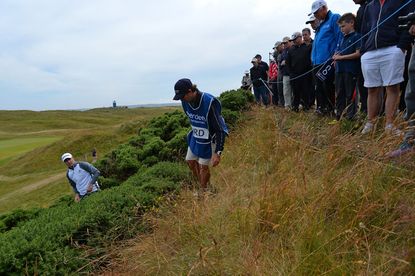Open Championship: The challenge of the links


Fergus Bisset on the thrill of watching the world's best players tackle a links course
Controversially for my first blog about this year’s Open Championship, I’m going to start by talking about another competition – last week’s Scottish Open at Royal Aberdeen.
Played over the majestic Balgownie links in wonderfully varying conditions, the event acted as the perfect amuse-bouche for this week’s main even at Hoylake. As an Aberdeenshire man, I must confess to being a little biased, but I think all who attended, or watched on TV, would have to agree the competition was a great success, attracting an excellent field and producing a worthy winner in Justin Rose.
Seeing the professionals tackle a links course is, for me, the ultimate as an armchair golf fan. The subtle challenges posed by a course like Royal Aberdeen, or those we’ll witness at Royal Liverpool this week, add a little spice to the occasionally bland professional golf that we see week in week out.
Take last week’s John Deere Classic on the PGA Tour as a case in point. Buzzing after watching the exciting, changeable and, at times, brutal golf coming from Royal Aberdeen, I felt inclined to keep the action coming so tuned in each evening to the PGA Tour coverage from TPC Deere Run. It was a rather different viewing experience.
Undoubtedly it takes great skill to hit straight drives and pinpoint approaches to hugely receptive greens. And I can only dream of holing so many yards of putts. In fact, I can’t even dream it – my night-time visions tend to involve more three-stabs and lip outs than moonrakers. But after a while watching the incessant excellence at TPC Deere Run, I began to get a little bored. How about a crazily unlucky bounce? What about an unplayable lie in a bunker or a hack out from the knee-high cabbage?
No, only links golf can deliver that kind of thrilling unpredictability to enhance the experience of watching professional golf to that extent. I can’t wait for this week’s competition to get underway, largely because it’s so difficult to say what will happen before it does and that’s a challenge to us as golf writers.
Get the Golf Monthly Newsletter
Subscribe to the Golf Monthly newsletter to stay up to date with all the latest tour news, equipment news, reviews, head-to-heads and buyer’s guides from our team of experienced experts.
On standard PGA Tour (and most European Tour) courses, it’s relatively easy to predict the players who might feature in a tournament – those who have fared well on the track in previous seasons and those on a good run of form on the circuit. With limited variables to affect the result, those fancied guys will be there or thereabouts at the end of the week.
But on the links, who knows? One half of the draw might get favourable weather conditions, as happened at St Andrews in 2010. One of the fancied players might shoot an 80 after losing their swing in the wind. The tournament could rest on a shot that bounces unkindly into a bunker, or one headed for trouble that kicks off a rumpled piece of ground and back towards the short grass.
And, because of the volatile nature of links golf, it’s much more of a mental test for the top players. The challenge is to stay patient and to accept the bad breaks as well as the good. Some find this easier to do than others – Justin Rose at Royal Aberdeen showed how to keep emotionally level no matter what the course and conditions throw at you. Rory McIlroy, on the other hand, went to pieces when things began to go awry on Friday. Phil Mickelson stated how mentally tiring it is to play links golf in testing conditions, and this is something the guys will have to contend with at Hoylake this week.
The man who lifts the Claret Jug on Sunday will not only have played superb, measured and strategic golf, but he will also have displayed mental fortitude, perseverance and tolerance. Simply put, he will be “The Champion Golfer” for the year.

Fergus is Golf Monthly's resident expert on the history of the game and has written extensively on that subject. He is a golf obsessive and 1-handicapper. Growing up in the North East of Scotland, golf runs through his veins and his passion for the sport was bolstered during his time at St Andrews university studying history. He went on to earn a post graduate diploma from the London School of Journalism. Fergus has worked for Golf Monthly since 2004 and has written two books on the game; "Great Golf Debates" together with Jezz Ellwood of Golf Monthly and the history section of "The Ultimate Golf Book" together with Neil Tappin , also of Golf Monthly.
Fergus once shanked a ball from just over Granny Clark's Wynd on the 18th of the Old Course that struck the St Andrews Golf Club and rebounded into the Valley of Sin, from where he saved par. Who says there's no golfing god?
-
 YouTube Star George Bryan Comes Within Inches Of PGA Tour Start At Qualifying Event
YouTube Star George Bryan Comes Within Inches Of PGA Tour Start At Qualifying EventThe YouTube star appeared set for a place at the Myrtle Beach Classic, but a near miss on the 18th left him in a playoff, which Matt Atkins won
By Mike Hall Published
-
 6 Mistakes Golfers Make When Choosing A Putter
6 Mistakes Golfers Make When Choosing A PutterJoe Ferguson examines how you can avoid some common pitfalls the next time you look to change putters
By Joe Ferguson Published